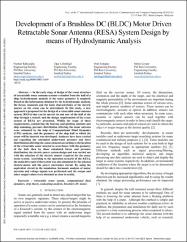Development of a Brushless DC (BLDC) Motor Driven Retractable Sonar Antenna (RESA) System Design by means of Hydrodynamic Analysis
Citation
Kâhvaoğlu, N., Çeltekligil, U., Erdoğan, O., & Çavdar, M. (2021, June). Development of a Brushless DC (BLDC) Motor Driven Retractable Sonar Antenna (RESA) System Design by means of Hydrodynamic Analysis. In 2021 International Conference on Electrical, Communication, and Computer Engineering (ICECCE) (p. 1-6). IEEE.Abstract
In the early stage of design of the crane structure of retractable sonar antenna systems extended from the hull of a ship, hydrodynamic analysis of the sonar geometry is required. Based on the information obtained by the hydrodynamic analysis, the forces, moments and the basic characteristics of the electric motors on the crane can be determined. In this study, a new approach is proposed for the design of a retractable sonar antenna system (RESA) that can be moved-in and out-of the hull of the ship through a tunnel; and the design requirements of the crane system of RESA are presented. Within the scope of these requirements, considering the heaving and pitching motions and ship slamming, pressure distribution affecting the sonar antenna were estimated by the help of Computational Fluid Dynamics (CFD) analysis, and the geometry of the ship hull to which the crane will be inserted was developed. Analyzes have been carried out regarding the calculated underwater pressure and force distributions affecting the sonar elements according to the location of the retractable sonar selected in accordance with the geometry of the hull, then by those calculated forces and pressure distribution, the electric power system design and was carried out with the selection of the electric motors required for the sonar crane system. According to the operation scenario of the RESA, the main drive unit of the system was also simulated by the selected electric-motor and the power electronics circuit. By using the equivalent circuit in the simulation, harmonic analysis of motor currents and voltage signals was performed and the torque and other output values were obtained as close to reality.

















